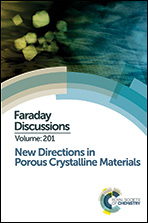Harvesting the photoexcited holes on a photocatalytic proton reduction metal–organic framework†
Abstract
The highly porous titanium based metal–organic framework NH2-MIL-125(Ti) has recently attracted significant attention in the field of photocatalysis as a promising material for H+ reduction. This work reveals charge transfer upon visible light illumination from this MOF to two different charge acceptors, as an alternative to sacrificial electron donors. Charge transfer is demonstrated through a combined spectroscopic study between this MOF and: (1) 2-(1H-pyrazol-3-yl)phenol, a molecule that functionally mimics the tyrosine–histidine pair, responsible for shuttling the holes to the oxygen evolving centre in natural photosynthesis, and (2) TEMPO, a well known and stable radical. Charge transfer of the holes from the MOF to these occluded molecules takes place on the picosecond time scale. This work suggests that, by coupling a stable and recyclable charge acceptor to the photogenerated holes, the charges can be utilised for oxidation reactions and, thus, link the reduction to the oxidation reactions in water splitting.
- This article is part of the themed collection: New directions in porous crystalline materials


 Please wait while we load your content...
Please wait while we load your content...